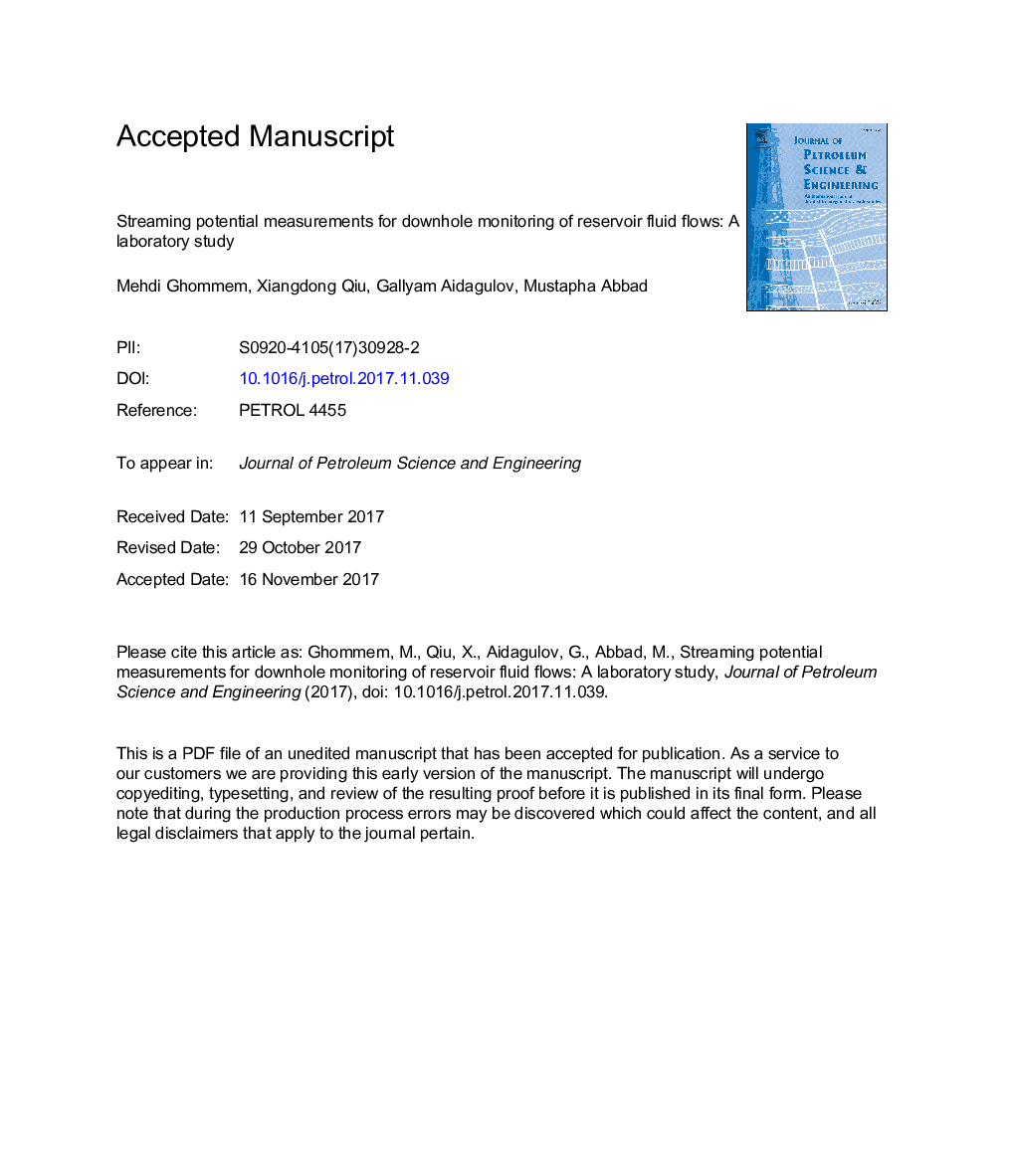| کد مقاله | کد نشریه | سال انتشار | مقاله انگلیسی | نسخه تمام متن |
|---|---|---|---|---|
| 8125392 | 1522780 | 2018 | 25 صفحه PDF | دانلود رایگان |
عنوان انگلیسی مقاله ISI
Streaming potential measurements for downhole monitoring of reservoir fluid flows: A laboratory study
ترجمه فارسی عنوان
اندازه گیری های پتانسیل جریان داده شده برای نظارت بر دریچه های جریان مخزن: یک مطالعه آزمایشگاهی
دانلود مقاله + سفارش ترجمه
دانلود مقاله ISI انگلیسی
رایگان برای ایرانیان
ترجمه چکیده
در این مقاله، ما یک مطالعه تجربی برای بررسی استفاده از اندازه گیری های پتانسیل جریان در نظارت بر جریان های سیال در رسانه های متخلخل برای عملیات تولید و تحریک انجام می دهیم. پتانسیل جریان از ناشی از حرکت مایع هدایت شده از طریق یک محیط متخلخل تحت یک گرادیان فشار کاربردی حاصل می شود. این از طریق یک فرآیند الکتروکینتیست منفعل تولید می شود که نیازی به منبع انرژی الکتریکی ندارد. دستگاه جریان هسته ای موجود با توانایی اندازه گیری های پتانسیل جریان در حال افزایش است زیرا روغن ها یا آب نمکی از ترکیبات مختلف و شور در جریان های مختلف جریان به نمونه های هسته ای کربنات در فشار بالا تزریق می شود. هدف اصلی ایجاد رابطه بین روند در تغییرات پتانسیل جریان و جریان سیال در هسته و توسعه پایه های تجربی در داخل تجهیزات جریان هسته ای است. اولین نتایج تجربی مطابق با داده های قبلا منتشر شده است که راه اندازی تجربی جدید را تایید می کند. این کار با انجام و تجزیه و تحلیل موارد آزمایشی اضافی نشان داده شده است که حساسیت پاسخ بالقوه جریان را بر ترکیب مایعات اشباع و نفوذ پذیری سنگ نشان می دهد. مقدار پتانسیل جریان در حال کاهش است زیرا شور شورا وارد شده به نمونه هسته افزایش می یابد و / یا نفوذ پذیری سنگ در هنگام حفظ همان نرخ تزریق مایع است. پتانسیل جریان نیز برای هسته اشباع نفت هنگام تزریق آب نمک اندازه گیری می شود. روند حاصل شده در پتانسیل جریان، نشان می دهد که استفاده بالقوه از چنین اندازه گیری هایی برای ردیابی جبهه آب در حین عملیات تولید است. هدف این است که پایه های آزمایشی را درون تجهیزات هسته ای ایجاد کنیم و این برای آزمایش بیشتر در مقیاس بزرگ استفاده می شود. انتظار می رود این امر درک بهتر فرآیند الکتروکینتیک را افزایش دهد و از عدم قطعیت ذاتی مرتبط با استفاده از پتانسیل جریان در این زمینه کاسته شود.
موضوعات مرتبط
مهندسی و علوم پایه
علوم زمین و سیارات
زمین شناسی اقتصادی
چکیده انگلیسی
In this paper, we conduct an experimental study to investigate the use of streaming potential measurements for downhole monitoring of fluid flows in porous media for production and stimulation operations. The streaming potential arises from the movement of conductive fluid through a porous medium under an applied pressure gradient. It is generated through a passive electrokinetic process that does not require any electrical power source. Existing coreflooding apparatus is enhanced with capability of streaming potential measurements as oils or brines of different composition and salinity are injected at varying flow rates into carbonate core samples at elevated pressure. The main objective is to establish a correlation between the trend in the variations of the streaming potential and fluid flow in the core and develop the experimental fundamentals within the coreflood equipment. First experimental results are found consistent with previously published data which verifies the new experimental setup. This is followed by performing and analysis of additional experimental cases showing the sensitivity of streaming potential response on the composition of the saturating fluid and the rock permeability. The magnitude of the streaming potential is observed to decrease as the salinity of the brine injected into the core sample is increased and/or rock permeability is higher when maintaining the same fluid injection rate. The streaming potential is also measured for oil-saturated cores while injecting brine. The obtained trend in the streaming potential demonstrates the potential use of such measurements to track the water front during production operations. The goal is to establish experimental fundamentals within the coreflood equipment and this will be used for a further large scale experiment. This is expected to enable a better understanding of the electrokinetic process and alleviate the inherent uncertainties associated with the application of the streaming potential in the field.
ناشر
Database: Elsevier - ScienceDirect (ساینس دایرکت)
Journal: Journal of Petroleum Science and Engineering - Volume 161, February 2018, Pages 38-49
Journal: Journal of Petroleum Science and Engineering - Volume 161, February 2018, Pages 38-49
نویسندگان
Mehdi Ghommem, Xiangdong Qiu, Gallyam Aidagulov, Mustapha Abbad,
